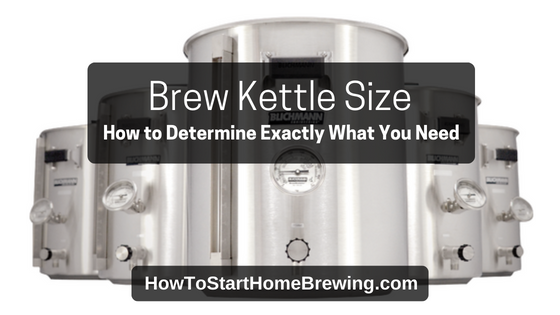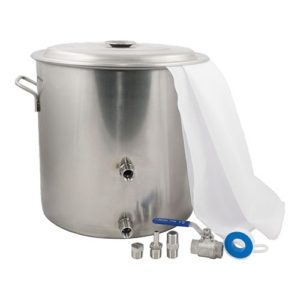One of the first questions a new homebrewer often asks is “What brew kettle size do I need?” The answer: It depends.
There are a lot of various factors that can go into what size of brew kettle you should use, such as:
- The overall batch size you’re targeting
- Your brewing method (i.e. brew-in-a-bag, extract, or the traditional method of mashing in a separate mash tun)
- The space you’re brewing in (i.e. on your stovetop in a kitchen or outdoors using a propane burner)
- Whether or not you want to add variation in your batch sizes
It’s a lot to think about, however, settling on the right brew kettle size isn’t all that difficult. If you’re stuck on what you should get, don’t worry, as we’ll dive into all of the specifics to help you come to a decision that is right for you!
Finding a Brew Kettle Based on Your Batch Size
The first question you should ask yourself is how big of a batch size you’re planning to brew on a regular basis. While 5 gallons is the most common, you can go as high (or low) as you desire.
That said, the most common rule of thumb is to go with a kettle size that is roughly 1.5 times the amount of the final volume you prefer to hit. Obviously, there are many other factors that can come into play, such as your targeted OG and desired brewing method, but this common rule will provide you with enough room to consistently brew a variety of beers without worrying about whether or not you’ll be stuck dealing with a mess due to a boil-over.
| Batch Size | Kettle Size |
|---|---|
| 1 gallon | 1.5 gallon |
| 2 gallon | 3 gallon |
| 3 gallon | 4.5 gallon |
| 5 gallon | 7.5 gallon |
| 10 gallon | 15 gallon |
By following the chart above, you can get a rough idea of the size of a kettle that would fit into your ideal brewing setup. Still, that may not paint the entire picture.
A Brew Kettle That Matches Your Brewing Method
Now that you know a common method of finding the right kettle size, you need to take into account your preferred brewing method. Depending on what you choose, this may slightly alter the size that would fit your setup the best.
Brew-In-A-Bag (BIAB)
The brew-in-a-bag method is one of the most common and lowest barriers of entry to all-grain brewing. Rather than following a traditional brewing process where the mash takes place in a separate mash tun, brew-in-a-bag allows you the convenience of mashing directly in the kettle itself. It’s a simple, no-hassle method that gives you all the benefits and control of going all-grain.
Most homebrewers that utilize the brew-in-a-bag method typically brew in smaller batches. It’s entirely possible to brew larger batch sizes using this method, however, you need to consider the overall weight of the grain after it’s completely soaked in water. For a 5-gallon batch, things can get quite heavy very quickly! In that case, those who brew anything larger than a 5-gallon batch typically use a pulley system to assist with lifting the bag out of the kettle, so it’s something you’ll want to consider if you’re going larger than the standard.
All in all, if you’re just getting started and plan to go the BIAB route, we’d recommend going with a smaller brew kettle. A 3 to 5-gallon kettle will give you all the flexibility you need and ensure you’re able to brew nearly any style of beer without worry.
Traditional All-Grain
A brewer who plans to go the traditional route and use a separate mash tun has a bit more flexibility, mostly due to the fact that they will not worry about hauling around a bag of wet grain during their brew day. While this has its benefits, there are other things to consider, such as:
- You will need a separate mash tun, which is another piece of equipment that you’ll have to add to your setup.
- While not overly difficult in the long run, this method requires a bit more skill and calculation in order to ensure you hit your OG and overall target volume.
- Often requires a brewing space with a bit more room.
All that said, those who are planning to dip their toes into traditional all-grain brewing can typically follow the table listed above as a general rule on brew kettle sizes.
Extract Brewing
Often a new homebrewer’s first foray into brewing, extract brewing is the easiest method to get started. The only drawback, however, is that it provides the least amount of control. That doesn’t mean you can’t make excellent batches of great-tasting beer using extract, but it leaves little room for getting as creative as you could with the other two methods listed above.
Due to the fact that you can do a full-boil with extract brewing, the same common rule for kettle sizes can be applied here. If you’re doing a 5-gallon batch size, a 7.5-gallon kettle will give you plenty of space. However, you may be able to get away with something slightly smaller, such as a 6.5-gallon kettle. Anything smaller for a traditional batch size technically could work, although you might be pushing it if you went as small as a 5.5-gallon kettle.
Your Brewing Space Matters

Another thing to consider before settling on the right size of brew kettle is your brewing space. Depending on where you plan to brew your batches, you may be limited in how big you can really go. This can also impact your decision on what brewing method you choose.
For example, if you live in an apartment and plan to brew on your stove, brewing a standard 5-gallon batch (whether using the traditional method or brew-in-a-bag) may not be the best choice due to the limited space available. We’re not saying it’s impossible, but it would certainly make things a bit cramped, which can lead to potential issues especially when you’re handling hot wort.
I think you can see where we’re going with this. You need a space that offers you comfort and makes getting around things during brew day easy. The larger the size of your space, the bigger you can allow yourself to go.
Flexibility for Future Batch Size Variations
Finally, one of the last things to consider when choosing the best brew kettle size is the flexibility you want to offer yourself.
What does that mean, exactly? If you think about the variety of beers you plan to brew, some recipes may be more special than others. If you’re brewing up one of your favorite IPAs that you know you’ll share with friends and family (and have plenty on hand for yourself), you might decide on a sizeable batch to ensure you’ll yield a supply to allow for that. On the other hand, brewing an imperial stout that requires a boatload of grain and other specialty ingredients may have you opt to brew a smaller batch size instead.
This is where thinking about the variety of batch sizes can help you zero in on a brew kettle that will fit your needs.
Here’s a scenario: You’re a beginner who is planning to follow the brew-in-a-bag method, but you’re on the fence about choosing 3 to 5-gallon batch sizes. Barring that all other considerations above have been thought over, it would be worth it to go for the larger kettle size, which would allow you to comfortably brew both batch sizes with ease. It will also ensure that you’ll save yourself some cash, as you won’t need to make an upgrade for a larger kettle in the event you wanted to go bigger.
Again, as long as other considerations have been met, it’s always better to go a bit larger.
Find the Right Brew Kettle Today
Now that you’re aware of all of the things you need to think about when choosing a kettle for homebrewing, you should know exactly what will fit your setup the best.
Of course, size is only half the battle. With so many kettles for homebrewing available, how do you know what to choose? Some are incredibly basic, while others are quite advanced and offer a variety of bells and whistles that can make your brew days smooth and consistent. It can be a bit overwhelming, but taking a look at what we think are the 5 best brew kettles should help make things a bit easier and less frustrating. You’ll be on your way to the perfect kettle in no time!


